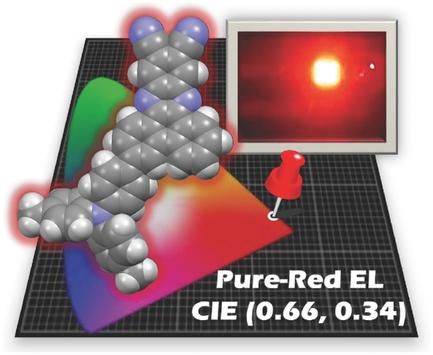当前位置:
X-MOL 学术
›
Adv. Opt. Mater.
›
论文详情
Our official English website, www.x-mol.net, welcomes your feedback! (Note: you will need to create a separate account there.)
Highly Efficient Red–Orange Delayed Fluorescence Emitters Based on Strong π‐Accepting Dibenzophenazine and Dibenzoquinoxaline Cores: toward a Rational Pure‐Red OLED Design
Advanced Optical Materials ( IF 9 ) Pub Date : 2018-01-16 , DOI: 10.1002/adom.201701147 Ryuhei Furue 1, 2 , Kyohei Matsuo 1 , Yasuhiko Ashikari 3 , Hirohito Ooka 3 , Natsuki Amanokura 4 , Takuma Yasuda 1, 2
Advanced Optical Materials ( IF 9 ) Pub Date : 2018-01-16 , DOI: 10.1002/adom.201701147 Ryuhei Furue 1, 2 , Kyohei Matsuo 1 , Yasuhiko Ashikari 3 , Hirohito Ooka 3 , Natsuki Amanokura 4 , Takuma Yasuda 1, 2
Affiliation

|
Organic luminescent materials that exhibit thermally activated delayed fluorescence (TADF) can harvest both singlet and triplet excitons for light emission, leading to high electroluminescence (EL) quantum efficiencies in organic light‐emitting diodes (OLEDs). However, efficient red TADF materials are still very rare because of their restricted molecular design based on the energy gap law. To address this issue, elaborate π‐conjugated donor–acceptor (D–A) systems that can simultaneously achieve a large fluorescence radiative rate and small singlet–triplet energy splitting should be strategically designed. In this study, to produce high‐efficiency pure‐red TADF materials, a remarkably strong π‐accepting dicyanodibenzo[a,c]phenazine (CNBPz) unit has been introduced in a D–π–A molecular framework, and combined with a phenylene‐linked p‐ditolylamine or 9,9‐dimethylacridan moiety. The steady‐state and time‐resolved photophysical measurements revealed intense genuine red TADF emissions of these CNBPz‐based molecules in both solution and doped thin films. The OLEDs incorporating the CNBPz‐based TADF emitters achieve the desired high‐efficiency pure‐red EL, centered at 670 nm with color coordinates of (0.66, 0.34), accompanied by a high maximum external EL quantum efficiency of 15.0%. Therefore, it is concluded that CNBPz, with its expanded π‐conjugation and strong electron‐accepting characteristics, is a particularly useful building unit to design long‐wavelength TADF materials that can overcome the intrinsic energy gap law obstacle.
中文翻译:

基于强π接受二苯并吩嗪和二苯并喹喔啉核心的高效红橙色延迟荧光发射体:朝着合理的纯红色OLED设计的方向发展
表现出热激活延迟荧光(TADF)的有机发光材料可以收集单重态和三重态激子用于发光,从而导致有机发光二极管(OLED)的高电致发光(EL)量子效率。然而,由于基于能隙定律的受限分子设计,有效的红色TADF材料仍然非常稀少。为了解决这个问题,应策略性设计精心设计的π共轭供体-受体(D-A)系统,该系统可同时实现大的荧光辐射率和小的单重态-三重态能量分裂。在这项研究中,要生产高效的纯红色TADF材料,需要使用一种非常强的π接受的二氰基二苯并[ a,c] phenazine(CNBPz)单元已引入D–π–A分子框架,并与亚苯基连接的p-二甲苯胺或9,9-二甲基ac啶部分。稳态和时间分辨的光物理测量结果显示,溶液和掺杂薄膜中这些基于CNBPz的分子强烈发射出真正的红色TADF。结合了基于CNBPz的TADF发射器的OLED实现了所需的高效纯红色EL,其中心波长为670 nm,色坐标为(0.66,0.34),同时具有最高的外部EL量子效率15.0%。因此,可以得出结论,CNBPz具有扩展的π共轭和强大的电子接受特性,是设计可克服固有能隙定律障碍的长波长TADF材料的特别有用的构建单元。
更新日期:2018-01-16
中文翻译:

基于强π接受二苯并吩嗪和二苯并喹喔啉核心的高效红橙色延迟荧光发射体:朝着合理的纯红色OLED设计的方向发展
表现出热激活延迟荧光(TADF)的有机发光材料可以收集单重态和三重态激子用于发光,从而导致有机发光二极管(OLED)的高电致发光(EL)量子效率。然而,由于基于能隙定律的受限分子设计,有效的红色TADF材料仍然非常稀少。为了解决这个问题,应策略性设计精心设计的π共轭供体-受体(D-A)系统,该系统可同时实现大的荧光辐射率和小的单重态-三重态能量分裂。在这项研究中,要生产高效的纯红色TADF材料,需要使用一种非常强的π接受的二氰基二苯并[ a,c] phenazine(CNBPz)单元已引入D–π–A分子框架,并与亚苯基连接的p-二甲苯胺或9,9-二甲基ac啶部分。稳态和时间分辨的光物理测量结果显示,溶液和掺杂薄膜中这些基于CNBPz的分子强烈发射出真正的红色TADF。结合了基于CNBPz的TADF发射器的OLED实现了所需的高效纯红色EL,其中心波长为670 nm,色坐标为(0.66,0.34),同时具有最高的外部EL量子效率15.0%。因此,可以得出结论,CNBPz具有扩展的π共轭和强大的电子接受特性,是设计可克服固有能隙定律障碍的长波长TADF材料的特别有用的构建单元。



























 京公网安备 11010802027423号
京公网安备 11010802027423号